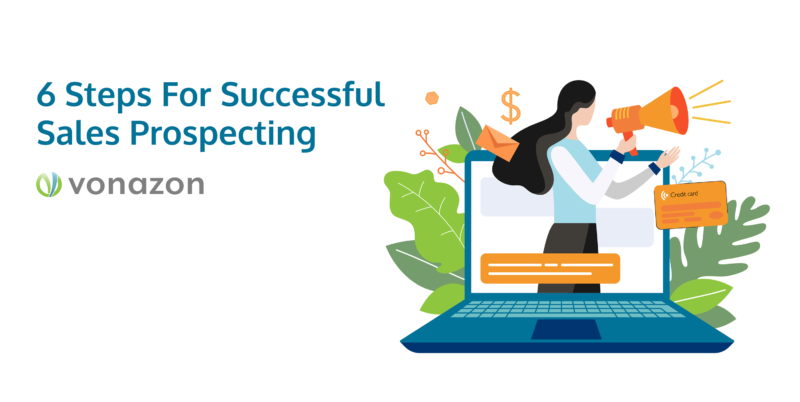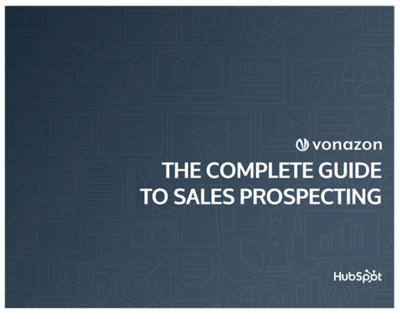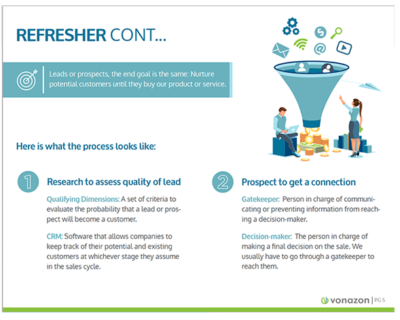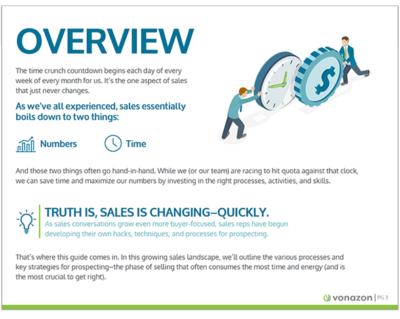
6 Steps for Successful Sales Prospecting
To be an effective sales rep, you must stay relevant, which requires using vital marketing tools such as successful sales prospecting. Sales are no longer as simple as merely going door to door or calling over the landline; the process has evolved over the decades with new technology. However, the end goal remains the same: keeping your ideal customer’s attention and avoiding them losing interest.
To help boost your sales marketing, Vonazon has assembled an effective how-to guide for deconstructing the prospecting process. In this guide, we’ll discuss the difference between leads and prospects and go through six steps sales reps should use to achieve the highest engagement levels with their target audience.
What is Prospecting?
Prospecting is the process of searching for potential customers, clients, or buyers to develop new business. The end goal is to move prospects through the sales funnel until they eventually convert into revenue-generating customers. For successful sales prospecting, sales reps need to start a conversation with prospects, determine if they’re qualified customers, and then position their products as a solution to an identified problem they’re experiencing.
Successful sales prospecting is important if firms want to raise sales without wasting time or resources. By integrating effective prospecting practices, firms can pinpoint potential customers for their products. Sales reps can then target these customers with personalized content, build healthy relationships, and encourage new sales by improving brand reputation.
Grab your FREE copy of The Complete Guide to Sales Prospecting
The truth is, sales is changing – quickly! In this guide we’ll outline the various processes and key strategies for prospecting – the phase of selling that often consumes the most time and energy (and is the most crucial to get right).
What’s a Lead vs a Prospect?
It’s a common misconception in sales marketing to view “leads” and “prospects” as interchangeable. While similar, a successful sales prospecting strategy recognizes that these terms involve different parts of the sales process. Simply put, every prospect can be a lead, but not every lead is a prospect.
The Lead
A lead is a potential customer interested in your products or services. These leads were moved into your top-of-the-funnel mailing lists as contacts after interacting with your digital content. On paper, leads can be ideal for your target market, but unless they’ve shown a commitment to buy your products, they’re classified as an “unqualified contact” and cannot fit your ideal buyer persona. If no replies are sent or zero intentions to buy your products are ever shown, these contacts become known as cold leads.
The Prospect
In contrast, a prospect is a qualified contact who does fit your ideal buyer’s persona. These leads are potential customers who’ve responded well to your advertisements, have the means to buy your offerings, and have shown intent to purchase. If these contacts meet all those criteria, they move down your sales funnel towards becoming sale opportunities. Once your sales reps have a prospect’s attention, they can tighten the funnel with personalized content such as blogs and emails guiding them toward finalizing a sale.
Step 1: Conduct industry and market research

On average, only 13% of prospects feel that sales reps care about their problems. Intensive market research is the best method to bridge that distrust because it shows you invested time to understand your prospect’s pain points. Search tools like Google or Owler are excellent for gathering the information you’ll need to identify potential leads by listening to decision-makers, industry news, and current trends. You’ll want to prioritize looking for “trigger events,” which are any outside factors signaling that now is the perfect time to engage with a prospect.
Step 2: Get to know your ideal customer
To find your most preferred clients, you’ll need to determine what you’re looking for by forming an ideal customer profile (ICP). This process begins by building a list of your best customers, then reviewing demographic data like age, location, and revenue to start identifying patterns that align with your sales. Next, you need to arrange in-person or phone interviews to collect ICP feedback and uncover missed information. Finally, examine this data against the personal traits of your clients’ job titles, interests, and core values to reveal your ideal customer.
Step 3: Build a list
This stage begins by knowing the ins and outs of your product. What value can prospects take from your product and which problems does it solve? Next, create a buyer’s persona for your target market by researching leads online. Social apps provide you a wide range of personal data and consumer preferences in one location. Once you have this buyer’s persona, you can start qualifying leads into prospects by email, phone, or in-person meetings. Here you will learn which prospects want to buy your product and if they possess the means to do so. Compare this information with industry data about prospects to create your perfect list of customers.
Step 4: Establish your communication channels

Today, advanced technology grants marketers several opportunities to reach out to leads, nurture them into prospects, and convert them to sales. 87% of sales reps prefer to use emails for lead generation when engaging with prospects for the first time. Sending an email is a loss-risk method of opening dialogue with your leads while granting you a chance to call and discuss why they need your product. Updating your website to include user-friendly options, such as chat boxes, comment sections, and recommended content links, will encourage leads to explore your offerings. Prioritizing the user experience makes it easier for leads to connect with your products when it’s convenient for them.
Step 5: Start the conversation
For successful sales prospecting, presentation is everything. The purpose of every sales call should be to keep the prospect talking for as long as possible. Start the conversation with insights you gained from market research about their industry. Bring up relevant challenges that typically affect the prospect or their company and position your product as a solution. Ask open-ended questions, which will keep them engaged, allowing you to learn about their needs and current issues while building their trust.
Step 6: Review your results and adjust accordingly
Once you’ve taken the time to contact all the leads who fit your ICP, it’s time to review the results. At this stage, you begin making regular adjustments to strengthen your client list by removing cold leads, leads who didn’t display high engagement rates, and those who could not buy the product. The final step is closing the sale by tightening the funnel using personalized content—the more specific your emails or blogs are for the prospect, the better.
Conclusion
Vonazon understands finding good-fit customers and closing sales is difficult, but with successful sales prospecting tips, it doesn’t have to be. Growing sales means having best relationship possible with your prospects. Invest time into learning their pain points. Speak with them and lead the discussion towards how you can solve those issues. Then gauge the response of each prospect against your ICP, and zero in on a target audience who wants you to provide them with a quick solution. Ultimately, you want to incorporate these unique solutions into your marketing through tailor-made emails and one-to-one meetings.
Grab your FREE copy of The Complete Guide to Sales Prospecting
Account Executive
Vonazon Inc.

Vonazon can guide you through the process of creating fun and effective short form videos that are unique to your brand. We can also help you create campaigns around your videos that deliver results, grow your brand’s social media presence, and produce more leads.
Contact us today to begin your short form video journey.
Recent Posts
Categories
Categories
- ABM
- Account Management
- Analytics
- Artificial Intelligence
- Content Marketing
- Creative
- CRM
- Design
- eCommerce
- Email Marketing
- HubSpot
- HubSpot CRM
- HubSpot Marketing Hub
- HubSpot Partner
- Inbound Marketing
- Integrations and Migrations
- Lead Generation
- Lead Scoring
- Marketing
- Marketing Automation
- Marketing Strategy
- Native Advertising
- Omnichannel Marketing
- Organization
- PPC
- Programmatic Advertising
- Sales and Marketing Alignment
- SEO
- Social Media
- Staffing
- Trade Shows
- Videos
- Web Development
- Webinars
HOW CAN We
HELP YOU?
Lorem ipsum dolor sit amet, consectetur adipiscing elit.







